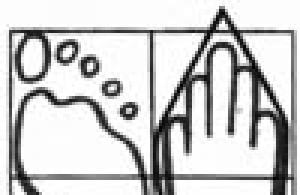The invention relates to the field of elevator engineering, in particular to methods for ensuring the accuracy of stops of passenger elevator cabins. The method for accurately stopping the floor of the elevator car at the level of the landing site is that the elevator control system generates commands given to the actuator, which is the winch brake, using the signals from the sensors in the shaft to slow down the object of the elevator control, fixes with the help of a measuring element the position of the elevator car and, based on the measurement results, generates a command to ensure the impact executive mechanism to the object of regulation. At the same time, the object of regulation, which is affected by the actuating element, is the cabin floor, combined with its threshold and separated from this cabin, and the effect of the mentioned actuator, located on the cabin itself, is carried out with the possibility of aligning the cabin floor level with the threshold level of the doors of the shaft of the selected landing site and occurs when the elevator car is stationary for a time not exceeding the time of opening the doors of the car and shaft on the selected landing site upon receipt of the corresponding signal of the measuring element. The signal at the time of switching on the actuator, which determines the distance to which it is necessary to move the cabin floor, is generated by a comparison device that compares the signal from the measuring element with the signal recorded in the memory and characterizing exact location the threshold of the doors of the shaft of the selected landing site, and a signal from the sensors-limiters that control the height of the floor. EFFECT: invention improves the accuracy of stopping the cab relative to the landing site. 4 ill.
The invention relates to the field of elevator engineering and, in particular, to methods for braking and achieving the accuracy of stopping cabins of passenger elevators. The vast majority of passenger elevators for mass construction houses contain a two-speed winch with a working speed of 1 m/s and a low speed of 0.6 m/s. A known method of stopping the elevator car (author's certificate 432077, 1973 RU Cl. B 66 B 11/04, author's certificate 260139, 1968 RU Cl. B 66 D 5/08), carried out when switching to low speed due to braking cabin with a brake shoe mechanism covering the winch pulley and driven in working condition using an electromagnet. Main disadvantage lies in the insufficient accuracy of the cabin stops on the landing sites. The reason for this phenomenon is that final result(accuracy of stopping the cab on the landing site) depends on a large number of factors: the state of the working surface of the friction linings of the shoes, the surface of the brake pulley, the tightening of the adjusting springs, the elasticity of the metal of these springs, the degree of uniform fit of the shoes to the pulley, adjusting the stroke of the electromagnet rod, the gap between the shoes and pulley, sampling gaps between the stem and cams, tractive effort electromagnet and the magnitude of the supply voltage. The regulated accuracy of the automatic stop of the cabin during operating modes of operation should be no more than +50 or -50 mm (the difference in height between the threshold of the cabin and the threshold of the doors of the landing shaft). This indication normative document Gosgortekhnadzor of Russia: "Rules for the device and safe operation elevators "NPO OBT Moscow, 1992 (PUBEL), paragraph 2.15. During operation, the accuracy of stops is often violated. This leads to inconvenience in using the elevator, it is possible for a passenger to be injured. An analysis of the functioning algorithm of such a well-known elevator shows the presence single-stage scheme adjusting the accuracy of the stops of the elevator car: when the moving car enters the exact stop shunt electronic circuit the control cabinet gives a signal to turn off the brake electromagnet and the pads under the action of the springs are superimposed on the brake pulley of the winch, stopping the cab. To improve cab stopping accuracy lifting machine and emergency braking, another well-known braking method is used (author's certificate 350744, 1969 RU Cl. B 66 D 5/00 B), adopted as a prototype, and a method close to it (author's certificate 716960, 1980 RU Cl. B 66 V 1/24). The method for controlling the emergency braking of the hoisting machine is based on the combined action of the actuating element 6 (service brake) and the actuating element 10 (emergency brake) on the control object 7 (hoisting machine) that stops the lifting vessel (cabin). The service brake operates on a system of stepless regulation of the braking torque depending on the location of the lifting vessel (cabin) and is controlled by the operation of the master device 4 and the comparison element 5, which generate an output signal on commands from a number of sensors 1-3 in the mine. The measuring element 8 controls the movement parameters of the lifting vessel in the mine (the degree of deceleration) and, depending on its value, connects one or the other brake. The emergency brake is additionally activated when the actual deceleration of the lifting vessel deviates excessively from the specified one. This two-stage braking scheme has found application in the mines of the mining industry. Its disadvantages are bulkiness, the presence of a large number of sensors in the mine and on the lifting vessel, the complexity and high cost of the lifting machine, the unresolved dependence of the accuracy of stopping the lifting vessel on numerous parameters of the service and emergency brakes, which are difficult to constantly monitor and adjust. All these factors make the control method described in the prototype unsuitable for mass-use elevators. The known method of increasing the accuracy of cabin stops is also inapplicable due to a significant decrease in the speed of the winch engine (up to 0.15 m/s) with subsequent activation of the shoe brake ( hospital elevators), because in residential buildings there are significantly more floor stops and the travel time in the cabin becomes excessively long, and the intensity of trips drops sharply. The objective of the invention is to create a two-stage method for regulating the accuracy of stops, on the one hand, using the main advantages existing method braking (by switching to low speed and turning on the electromagnet of the shoe spring brake - the first stage), and on the other hand, bringing the cabin floor to the level of the landing with the required accuracy - the second stage. The invention is based on the design of the most massive passenger elevators with a carrying capacity of 400 and 630 kg, which are produced by well-known factories: Karacharovsky Mechanical Plant, Shcherbinsky Elevator Plant. These elevators are equipped with a passenger elevator control system for residential buildings with pair control up to 17 floors (EILA. 655114.002-01). The problem is solved: - by introducing a chain feedback into the system electronic control an elevator, which gives a signal about the actual location of the elevator car in the area of its stop on a given floor when a conventional shoe brake is actuated; - formation of a control signal proportional to the deviation of the cabin location from the specified one (the level of the clean floor of the landing area, the threshold of the doors of the landing shaft shaft); - movement (lifting, lowering) for a short distance of the movable floor of the fixed elevator car, combined with the threshold of the car, during the opening (closing) of the car doors and the shaft on the selected floor. The technical implementation of the proposed method consists in: 1) installing a new layer on the cabin, which combines its direct functions of opening the shaft doors, acting on the shaft door roller, with the function of determining the location of the stopped cabin, relative to the fixed shaft doors of a given landing site due to a line of non-contact sensors , forming a measuring element; 2) in the structural combination of the movable cabin floor with the cabin threshold into a single product that can move in the vertical plane from the drive mechanism acting on it (hydraulic cylinder, electric drive with crank mechanism etc.); 3) in new design the threshold of the car doors, which ensures the joint interaction of the threshold and the doors of the cabin during vertical movements of the threshold (together with the movable floor) and does not violate the requirements for the safe use of the elevator; 4) in the use of a drive mechanism for raising and lowering the movable floor of the cabin with passengers to an insignificant height (a hydraulic cylinder is preferable - noiselessness and smoothness when moving a large load over a short distance); 5) run electronic block in common system elevator control, which implements the following functions: signal processing from a line of sensors installed on a new branch; issuance of command signals for the operation of the drive mechanism of the floor; tracking the operation of the cabin door drive; generating a signal for the neutral position of the cabin floor, in which the cabin is located when moving between floors; checking the safety of the operation of the second stage of adjusting the accuracy of stopping the elevator car. Fig.1-4 explain the claimed method. For a better understanding of the proposed method for achieving an accurate stop of the cabin floor on the selected landing site, figure 1 shows the enlarged components of the block diagram: deceleration sensors 1 and 2, precise stop sensors 3; elevator control system 4; actuating device 5 (electromagnetic shoe brake of the winch); moving object 6 (elevator car); control object 7 (movable cabin floor); measuring element 8; comparator 9; storage device 10; actuator 11; sensors limiters 12. Let's consider the operation of the proposed flowchart of the method for achieving an exact stop of the cabin, shown in Fig.1. The electronic control system 4 sets the algorithm for the operation of the elevator. In particular, let us consider the case when a passenger in the cabin, by pressing the command button, sets the direction of movement of the cabin towards the selected floor. In this case, the control system 4 generates a number of commands: the winch motor is turned on, the actuator 5 is activated - they are pressed brake pads activated electromagnet, the speed and direction are selected, the cabin doors are closed, etc. As a result, the movement object 6 - the elevator car - moves towards the desired floor. When the cab approaches a given floor, the cab slows down, switching to low speed at the command of the control system 4, which received a signal from the deceleration sensor 1 or 2 in the mine. The signal to stop the car is an impulse from the exact stop sensor 3, which is generated when this sensor on the car enters the shunt of the required floor. The shunt of each floor is installed on the guide in the shaft in the middle position so that the threshold of the cabin is flush with the threshold of the doors of the shaft of this floor, both when the cabin approaches this floor from above, and when approaching it from below. At the same time, it is difficult to take into account all the factors that affect the stopping accuracy: cab load, condition and operation of the winch brake. The signal generated when the cab enters the exact stop zone causes the control system 4 to decelerate the cab, which generates a command to turn off executive device 5. The brake solenoid is de-energized and the spring shoe brake mechanism stops the car within the specified floor. When the door drive is turned on, the cabin sliding acts on the portal roller of the shaft doors and starts to open them. This concludes the first stage of regulation implemented in modern mass elevators. The combination of the moving floor of the stopped cabin (regulated object 7) with the threshold of the shaft doors can be made with a certain degree of error. On the graph of Fig. 2 shown possible options car stop and its threshold relative to the threshold of the shaft doors of the selected floor. At this stage, the second stage of regulation, developed by the author, begins to work. The line of non-contact sensors of the measuring element 8, placed on the cabin outlet, generates a signal about real position stopped cabin in the shaft relative to the portal of the doors of the shaft of a given floor. Optical (infrared, for example) rays of the sensors of the measuring element 8 fix the roller of the portal of the doors of the mine, which entered into the cab lining. On the comparison device 9, a comparative analysis of the signal from the sensor line of the measuring element 8 and the signal previously recorded in the memory of the storage device 10, which characterizes the exact position of the control object 7 (the floor of the cabin, structurally aligned with the threshold of the cabin) with the threshold of a given floor, is carried out. If there is a difference in the levels of thresholds greater than a predetermined critical value, for example 5 mm, a signal proportional to the deviation is generated at the output of the device 9. This signal organizes the activation of the actuator 11 (hydraulic cylinder, electric drive), which moves the control object 7 (raises or lowers the floor of the fixed cabin) to the required height until the output signal from the comparison device 9 disappears. up and limit-maximum movement of the floor down; limiting the number of cycles of movement of the cabin floor on one floor area, set programmatically in the comparison device 9; mechanical stops that physically limit the area of movement of the cab floor. For the safety of tall passengers, it is recommended to limit the maximum floor lift in the cabin to a value of 50 mm, controlled by sensors, limiters 12 and mechanical stops. In the event of an abnormal rise (lowering) of the floor by the actuator 11 over a distance of more than 50 mm, the limiter sensor 12 is activated and, through the comparison device 9, turns off the power supply circuit of the actuator 11. In the event of a failure of the comparison device 9 or the limiter sensor 12, the floor acts on the mechanical stops of the cab, which with break switch electrical circuit actuator power supply. The graph of figure 3 shows the time parameters of this process, and it is important that the total time t 1 +t 2 does not exceed the time for which the cabin doors open t 3 . The graph of figure 4 shows the action of the second stage of regulation of the accuracy of stops for three possible cases. Case 1 - the cabin and its floor and its threshold stopped in the field of the difference between the thresholds allowed by PUBEL, and yet this creates inconvenience for passengers. In this case, a command is sent from the comparison device 9 to turn on the actuator 11 and the cabin floor is aligned with the threshold of the shaft doors of the selected floor. The leveling process is controlled by the measuring element 8. Case 2 - the cabin did not reach the floor door threshold for a considerable distance (60-150 mm). In this case, at the command of the comparison device 9, which recorded the error using the measuring element 8, the control system 4 turns on the actuator 5 and the winch drive moves the elevator car down by 100 mm at low speed until the floor and the threshold of the car enter the zone of permissible stops, where then the cab floor is brought to the level of the door floor, as described in the first case. Case 3 - the cabin passed the zone of permissible stops and dropped below the threshold of the shaft doors for a considerable distance (60-150 mm). At the command of the comparison device 9, the control system 4 briefly switches on the actuator 5, which raises the cabin 100 mm up until it enters the zone of permissible stops, where the cabin floor is brought up to the level of the door threshold of the floor shaft, as in case 1. If the moving object 6 stopped from the door threshold of the shaft of the selected floor at a distance of more than 150 mm, then a signal is generated from the comparison device 9 to the input of the control system 4. The control system generates commands to turn on the actuator 5 and move the elevator car at low speed to the selected floor. In this case, the operating time of the winch motor is selected in such a way as to move the cabin to a regulated distance, for example, not less than 100 mm. This process continues up to two times, inclusive, if the cabin has not entered the zone of operation of the second stage of regulation after the first cycle of arrival. The work of the second stage of regulation takes place during the opening of the elevator doors and ends with the alignment of the thresholds of the cabin and the doors of the mine with a given accuracy. At the next cycle of the cabin movement to another floor selected by the passenger, the actuator 11 sets the control object 7 (cabin floor) to neutral position: position in which the cab floor can be raised or lowered by a regulated distance of 50 mm. This is necessary for the implementation of the subsequent control cycle on another given floor. The practical implementation of the proposed control method in elevators is achieved through the use of many mass-produced products already used in them: winches, control stations, shaft doors, guides, counterweights, shunts and sensors. The refinement of the elevator car affects four positions: the movable floor is combined with the threshold of the new design; the cab door, due to the new design of its lower part, does not leave the threshold when moving it up and down a regulated distance; at the bottom of the cabin, the floor drive actuator is installed, while the drive itself can be at the top of the cabin, where it is available for inspection and repair; the layer is combined with a line of optical sensors and a mating electronic board. The comparison device and the storage device are implemented on discrete logic digital elements electronic board and can be placed in a control system cabinet, for example, based on a microprocessor, SHULC (developer - MEL, Moscow).
Stops) - the vertical distance between the level of the floor of the car and the level of the floor area after the automatic stop of the car..."
A source:
Gosgortekhnadzor of the Russian Federation of May 16, 2003 N 31 "On approval of the Rules for the design and safe operation of elevators" (Registered in the Ministry of Justice of the Russian Federation on May 27, 2003 N 4597)
Official terminology. Akademik.ru. 2012 .
See what "Elevator cab stop accuracy" is in other dictionaries:
stop accuracy- 3.4 stopping accuracy: The maximum vertical distance between the thresholds of the car and landing at the moment the car is stopped by the elevator control system on the destination floor at full open doors mines. Source: GOST R 52626 2006: Elevators ...
Stop accuracy: the maximum vertical distance between the thresholds of the car and the landing at the moment the car is stopped by the elevator control system on the destination floor with the shaft doors fully open... Source: ELEVATORS. ASSESSMENT METHODOLOGY… … Official terminology
accuracy 3.1.1 accuracy degree of closeness of a measurement result to an accepted reference value. Note The term "accuracy" when it refers to a series of measurement results includes a combination of random components and an overall systematic ... ... Dictionary-reference book of terms of normative and technical documentation
GOST R 53780-2010: Elevators. General safety requirements for the device and installation- Terminology GOST R 53780 2010: Elevators. General requirements to the device and installation original document: 3.12 "shut-off" valve: A manually operated two-way valve that allows or blocks the flow of fluid. Definitions… … Dictionary-reference book of terms of normative and technical documentation
GOST R 51631-2008: Passenger lifts. Accessibility specifications, including accessibility for the disabled and other people with limited mobility- Terminology GOST R 51631 2008: Passenger lifts. Technical requirements accessibility, including accessibility for people with disabilities and other people with limited mobility original document: 3.2 mixed simple push-button control: ... ... Dictionary-reference book of terms of normative and technical documentation
Elevator- (from the English lift to lift) a stationary lift, usually of intermittent action with a vertical movement of the cabin or platform along rigid guides installed in the shaft. There were prototypes of L. in ancient Rome as early as the 1st century. BC er,… … Great Soviet Encyclopedia
GOST R 52626-2006: Elevators. Methodology for assessing and improving the safety of elevators in operation- Terminology GOST R 52626 2006: Elevators. Methodology for assessing and improving the safety of elevators in operation original document: 3.5 owner of the installation (elevator): Physical or entity owned, owned, ... ... Dictionary-reference book of terms of normative and technical documentation
system- 4.48 system combination of interacting elements organized to achieve one or more stated objectives Note 1 to entry: A system can be viewed as a product or the services it provides. Note 2 In practice… … Dictionary-reference book of terms of normative and technical documentation
Control- 2 Management A set of purposeful actions, including an assessment of the situation and the state of the control object Selection of control actions and their implementation (GOST 34.003 90). With regard to personnel (as an object of management) under the control of ... ... Dictionary-reference book of terms of normative and technical documentation
Operation Flashpoint: Cold War Crisis- Operation Flashpoint Developer Bohemia Interactive Studio Publishers ... Wikipedia
Elevator (English lift - rise, raise) - a widely used type lifting machines designed for lifting / lowering goods and people. The main features that distinguish the elevator from other lifting devices include stationarity and the presence of straight guides located at an angle to the vertical by no more than 15º. According to the mode of operation, the elevator is a batch machine.
Requirements for the device, installation, operation, maintenance, diagnostics of elevators and SDK are regulated by PUBEL (“Rules for the Design and Safe Operation of Elevators”).
Types of elevators
Elevators are classified according to many parameters. Depending on the type of transported cargo, the following categories of equipment are distinguished.
Passenger elevators. Installed in public, residential and industrial buildings, designed to transport people and household items, the weight of which does not exceed the allowable values.
sick leave. Designed for medical facilities, serve to lift / lower those on medical vehicles patients and accompanying physicians.
Freight. Used for lifting / lowering various loads. By way of management and design features freight elevators subdivided into the following types:
- operated by a lifter (conductor) from the cab.
- controlled from floor areas closed to the movement of people;
- small load-lifting elevators with a cabin up to 1250 mm high and up to 250 kg capacity;
- elevators with a ceiling beam-monorail, which serves to secure the load-lifting devices;
- squeeze lifts, the movement of which is carried out as a result of the application lifting force to the bottom of the cab.
- sidewalk elevators located in underground shafts, having a hatch in the upper part for the elevator exit.
Main technical specifications elevators
Load capacity. The maximum weight of a load that can be lifted using an elevator. The weight of the cab with all the equipment in it is not included in the load capacity. The nominal capacity of the lift depends on the floor area of the cabin.
Capacity. This is the number of people who can be in the elevator at the same time. It is equal to the quotient of dividing the carrying capacity of the machine by the average weight of a person, which is assumed to be 75 kg. The resulting fractional value is rounded to the nearest integer.
Stop Accuracy elevator. The distance between the level of the platform on the floor and the floor of the stopped car. Deviation in one direction or another is not more than 35 mm.
Movement speed. Distinguish between nominal and operating value. The first is the calculated value of the cab movement speed. The second is the actual one, which takes place during operation. According to the speed of movement, elevators are divided into four categories:
- high speed(nominal cab speed above 4 m/s);
- high-speed(movement occurs at a speed located in the range of 2.0-4.0 m/s);
- high-speed(1-2 m/s);
- slow-moving(up to 1 m/s).
Is there some more two-speed elevators, in which the speed decreases to 0.4 m / s before stopping. This improves the stopping accuracy of the cab.
Type of load-carrying platform. The elevator can have a standard cabin or a platform.
Type of door drive. It differs in the way of opening:
- auto;
- semi-automatic;
- manual.
By type of actuator (type of energy consumed):
- hydraulic;
- electric.
elevator control system
The control system is classified according to two criteria: the place from which control is carried out, and the nature of the supply and reception of control commands.
The elevator can be controlled from the following locations:
- outside the cabin (from the platforms on the floors) - outdoor or external control;
- from the cockpit internal control;
- simultaneously from the cabin and from the landing - mixed control.
Depending on the algorithm for receiving and executing commands, the following control methods can be implemented.
Simple separate control. This is the case when only one command is received and executed.
Collective. With this method, several commands are received and registered, but the order of their execution is determined by the program embedded in the control system. The collective control method involves intermediate stops, at which passing passengers are picked up from the floor areas. On elevators operating in residential buildings, intermediate stops are allowed only when the car is lowered. In elevators operating in public buildings, the control system implements intermediate stops both when moving down and up.
single. The elevator is controlled by a single call button.
group. Implemented for a group of elevators that are located in the same shaft and operate on the same floors. One of the options for this type of control is pair control, often used in residential buildings.
Elevator operating modes
There are the following modes of operation:
Worker. Used when moving passengers.
Maintenance mode. It assumes control of the cab from the engine room, in which there is an electrician who maintains the equipment.
Revision. Management is carried out by an electrician located on the roof of the cab.
fire hazard. The transition to this mode occurs when a fire signal is received. The electrical circuit of the elevator in this case ensures the supply of the cabin to the main landing floor, ignoring commands coming from other places (landing area or cabin).
Transportation of firefighters. Controlling the movement of the elevator, as well as closing / opening the doors of the shaft / cabin is possible only from inside the cabin.
2016.07.05 2 3 9 ..
General requirements for the design and parameters of elevators
Safety of use and reliability of operation are the fundamental requirements on which the design, manufacture and operation of elevator equipment is based. These requirements are reflected in PUBEL, GOST and Specifications for the design of elevators.
Along with the above, the following additional requirements are imposed on elevators: stopping accuracy relative to the level of the floor area; smooth cab movement during acceleration and deceleration; comfortable conditions for the transportation of passengers; public access to the use of the elevator; noiselessness of work; allowable level electromagnetic interference to the operation of radio communication and television systems.
The accuracy of the cab stop is determined by the difference between the elevations of the cab floor and the landing floor. The threshold formed as a result of inaccurate stopping poses a danger to passengers and makes loading and unloading operations difficult using floor vehicles or a monorail cabin loading system.
The inaccuracy of the stop is determined by the dependence of the braking distance of the cab on the mass of the load and the direction of movement at the moment of braking.
When braking an ascending loaded cabin, the stop will occur slightly below the threshold of the unloading platform, while the empty cabin will travel a longer distance and stop above this level. When moving down, the reverse picture will be observed.
The shunts of the cab exact stop sensor are installed at such a distance that the difference between the levels of the cab floor and the landing is the same when the loaded and empty cabs stop when it moves in the same direction. This is shown schematically in Fig. 1.2.
It is customary to estimate the stopping accuracy by the value of the half-difference of the braking distances of the cabin when moving in the same direction with the load and the empty car:
According to the recommendation of PUBEL, the accuracy of stopping the cabin must be maintained within limits not exceeding: for hospital elevators and freight elevators with a monorail ± 15 mm; for the rest - ±50 mm. Using controlled drive variable three-phase current and drive direct current significantly higher stopping accuracy is achieved.
The smoothness of the cabin movement is quantitatively determined by the level of acceleration during acceleration and deceleration of the lifting mechanism.
According to PUBEL standards, the maximum value of acceleration (deceleration) of the cabin in normal operating conditions should not exceed the following values: for hospital elevators - 1 m / s2; for elevators of other types - 2 m / s2.
The maximum deceleration when the cab is stopped by pressing the STOP button should not exceed 9.81 m/s2.
When landing the cab on the catchers or buffer in emergency situations accelerations up to 25 m/s2 are allowed. „
The effect of the physiological impact of accelerations essentially depends on the time of their action. So, when the time of action of accelerations is less than 0.04 s, the human body satisfactorily tolerates accelerations of about 30-40 m/s2. Therefore, PUBEL allows for a short-term excess of the car deceleration accelerations.
The comfort of the passenger transportation conditions is determined by the minimum waiting time for the elevator on the landing site, the smoothness and accuracy of the stop, the absence of noise and vibration in the cabin, the presence of good interior ventilation and sufficient lighting.
Comfort is further enhanced by the attractive cab trim, with a well-thought-out range of colors that create the effect of increasing cabin space.
The general accessibility of using the elevator implies the presence of a fairly simple and understandable traffic control system from the cabin and floor areas, which does not require special training for passengers of all age groups.
Noiseless operation of the elevator is ensured by a number of measures to reduce the noise level and prevent its spread along the supporting structures of the building. To this end, the elevator winch and other components of the elevator equipment are mounted on shock absorbers and their design is subject to increased requirements regarding the level of noise and vibration. These requirements must be taken into account when carrying out installation, maintenance and repair work.
Specifications for the design of elevators, the maximum permissible noise level in rooms located next to the elevator is also regulated. The relevant regulatory data depend on the purpose and technology of use of the respective building.
Reducing the level of electromagnetic interference can be guaranteed by good quality shielding of interference sources of the elevator's electrical equipment and the installation of high-frequency filters in the input device of the elevator's electrical power circuit.









